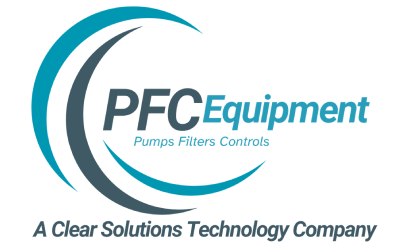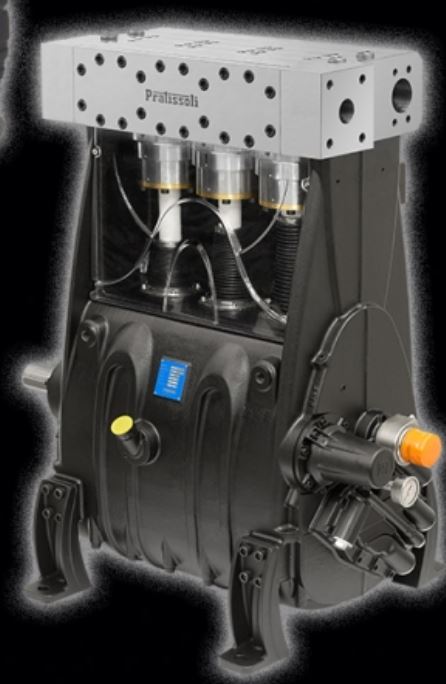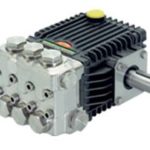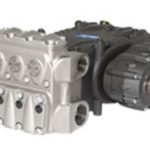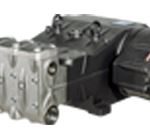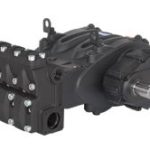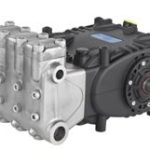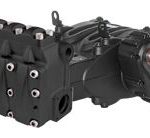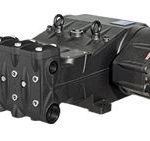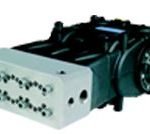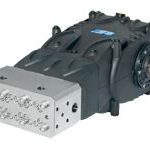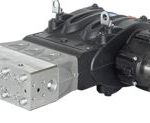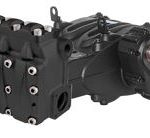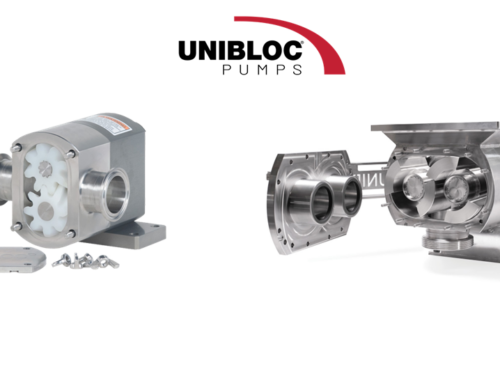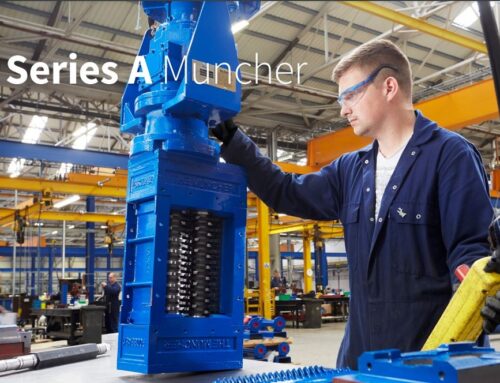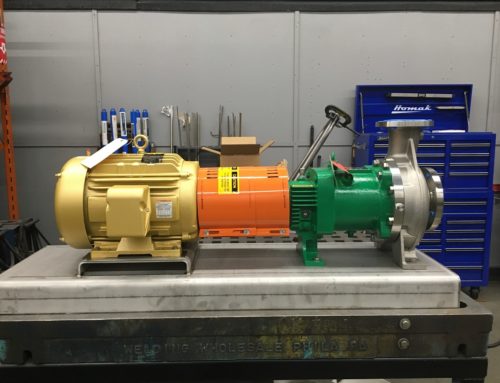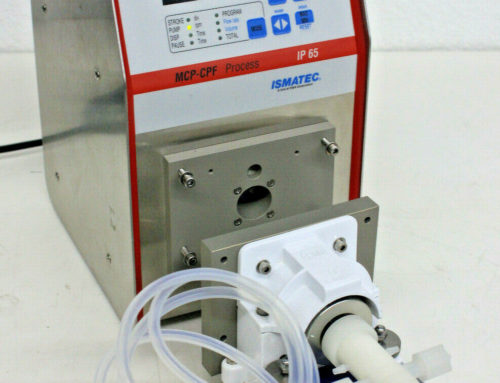General Pumps selection of pressure cleaning pumps, ranging from 400 to 7250 psi, with flows from 1 to 50 GPM. The pumps are used in automotive, surface cleaning, household exterior cleaning, pre-painting surface preparation, heavy equipment maintenance, and various types of contract cleaning.
“HR” coating on manifold 30 times more resistance to salt water mist from road spray
Triplex Plunger Pump, available in 5 plunger diameters
Patent-pending, symmetrical power end design featuring top and bottom mounting holes allowing for easy left to right shaft conversion
Low-high pressure packing design with integrated cooling system,
no greasing required
High volumetric efficiency suction/delivery valveseaturing new spherical design of sealing areas
Splash lubrication
SAE-B hydraulic drive available with hollow splined shaft or bell housing
Maximum Inlet Pressure: 45 PSI
Maximum Fluid Temperature: *140° F
Inlet Port Thread: 1” NPT-F
Discharge Port Thread: 1/2” NPT-F
Shaft Diameter: 1.102”/28 mm
Stroke: 1.379”/35 mm
Pump Dimensions: 17.1” x 12.1” x 6.8”
Crankcase Oil Capacity: 60.7 oz. (1.8 liters)
General Pump offers a complete line of stainless steel industrial pumps to meet the needs of aggressive environments. All General Pumps are ISO 9001 certified, and our stainless steel line offers flows from 2.1 GPM to 104.3 GPM. These pumps feature 316 stainless steel manifolds and wetted parts to ensure years of trouble free operation in aggressive environments. As always, all pumps are available as custom engineered power units that include a heavy-duty steel or stainless steel base, pump, drive (electric, gas or diesel), and system accessories.
Flows from 24.0 GPM to 59.7 GPM
Patent-pending symmetrical power end featuring top and bottom mounting holes allowing for easy left to right shaft conversion
Low-high pressure packing design with integrated cooling system
High volumetric efficient suction/delivery valves
Splash lubrication
SAE-C drive options available
Available with external gear box (direct drive only)
KS Series – Specifications:
Max. Inlet Pressure: 45 PSI
Max. Fluid Temperature: *140° F
Inlet Port Thread: 2″ NPT-F
Discharge Port Thread: 1-1/2″ NPT-F
Shaft Diameter: 1.575″/40 mm
Stroke: 1.969″/50 mm
Pump Dimensions: 23.0″ x 19.0″ x 11.0″
Flows from 40.7 GPM to 107.3 GPM
Low-high pressure packing design with integrated cooling system
High volumetric efficient suction/delivery valves
Splash lubrication
Gear ratios: 1500 RPM=2.65:1, 1800 RPM=3.29:1
Includes drain/priming valve kit
SAE-D hydraulic drive available (w/1500 RPM version only)
Nickel-plated cast iron manifold
MK Series – Specifications:
Max. Inlet Pressure: 45 PSI
Max. Fluid Temperature: *140° F
Inlet Port Thread: See specification sheet
Discharge Port Thread: See specification sheet
Shaft Diameter: 2.165″/55 mm
Stroke: 2.835″/72 mm
Pump Dimensions: 32.64″x29.38″x14.25″
Crankcase Oil Capacity: 456.5 oz./13.5 liters
Use GP Series 220 Oil
Flows from 37.0 GPM to 111.8 GPM
Drive shaft with double projectionDouble pressure packings
Splash lubrication
Vertically fitted suction/delivery valves
Includes drain/priming valve kit
Gear ratios: 1500 RPM=2.95:1, 1750 RPM=3.158:1, 1900 RPM=3.389:1
Nickel-plated cast iron manifold
ATEX Available
LK Series – Specifications:
Max. Inlet Pressure: 45 PSI
Max. Fluid Temperature: *140° F
Inlet Port Thread: See specification sheet
Discharge Port Thread: See specification sheet
Shaft Diameter: 1.969″/50 mm
Stroke: 3.546″/90 mm
Pump Dimensions: 36.4″ x 26.4″ x 13.7″
Crankcase Oil Capacity: 473.5 oz./14 liters
Use GP Series 220 Oil
Flows from 36.9 GPM to 105.4 GPM
Low-high pressure packing design with integrated cooling system
Vertically fitted suction/delivery valves
Splash lubrication
Gear ratios: 1500 RPM=1.876:1, 1800 RPM=2.238:1, 2200 RPM=2.722:1, 2600 RPM=3.25:1
Includes drain/priming valve kit
F2152 kit allows for easy adaptation to MSS mounting pattern
SAE-C hydraulic shaft/flange option available
Nickel-plated cast iron manifold
ATEX Available
MW/MWS Series – Specifications:
Max. Inlet Pressure: 45 PSI
Max. Fluid Temperature: *140° F
Inlet Port Thread: See specification sheet
Discharge Port Thread: See specification sheet
Shaft Diameter: 1.969″/50 mm
Stroke: 2.756″/70 mm
Pump Dimensions: 29.5″ x 23.0″ x 14.5″
Crankcase Oil Capacity: 304.3 oz./9 liters
Use GP Series 220 Oil
Flows from 7.2 GPM to 37.5 GPM
Double pressure packings
Pressure packing design with integrated cooling system
Horizontally fitted in-line valves
Splash lubrication
SAE-B hydraulic drive options available
420 SS manifold (KT16A, 18A, 20A, 22A)
Nickel-plated cast iron manifold (KT24A, 28A, 30A, 32A, 36A, 40A)
KT Series – Specifications:
Max. Inlet Pressure: 45 PSI
Max. Fluid Temperature: *140° F
Inlet Port Thread: See specification sheet
Discharge Port Thread: See specification sheet
Shaft Diameter: 1.181″/30 mm
Stroke: 1.102″/26 mm
Pump Dimensions: 15.55″ x 13.4″ x 8.35″
Crankcase Oil Capacity: 67.63 oz./2 liters
Use GP Series 220 Oil
Flows from 12.1 GPM to 15.1 GPM
Patent-pending symmetrical power end featuring top and bottom mounting holes allowing for easy left to right shaft conversion
Low-high pressure packing design with integrated cooling system
High volumetric efficient suction/delivery valves
Splash lubrication
SAE-C drive options available
Available with external gear box (direct drive only)
420 SS manifold (HS18A is 17/4 ph)
HS Series – Specifications:
Max. Inlet Pressure: 45 PSI
Max. Fluid Temperature: *140° F
Inlet Port Thread: 1″ NPT-F
Discharge Port Thread: 3/4″ NPT-F
Shaft Diameter: 1.575″/40 mm
Stroke: 1.969″/50 mm
Pump Dimensions: 21.4″ x 14.5″ x 9.4″
Crankcase Oil Capacity: 128.5 oz./3.8 liters
Use GP Series 220 Oil
Flows 71.0 GPM to 106.0 GPM
Packings/plungers serviceable without removing manifold
Splash lubrication
Gear ratios: 1500 RPM=1.876:1, 1800 RPM=2.238:1, 2200 RPM=2.722:1, 2600 RPM=3.25:1
Nickel-plated cast iron manifold
F2152 kit allows for easy adaptation to MSS mounting pattern
MF Series – Specifications:
Max. Inlet Pressure: 45 PSI
Max. Fluid Temperature: *140° F
Inlet Port Thread: See specification sheet
Discharge Port Thread: See specification sheet
Shaft Diameter: 1.969″/50 mm
Stroke: 2.756″/70 mm
Pump Dimensions: 29.5″x23.0″x14.5″
Crankcase Oil Capacity: 304.3 oz./9 liters
Use GP Series 220 Oil
Flows from 48.4 GPM to 128.2 GPM
Low-high pressure packing design with integrated cooling system
High volumetric efficient suction/delivery valves
Splash lubrication
Gear ratios: 1500 RPM=2.23:1, 1800 RPM=2.65:1, 2200 RPM=3.29:1
Includes drain/priming valve kit
SAE-C hydraulic drive available (w/ 2500 RPM version only)
SAE-D hydraulic drive available (w/ 1800 RPM version only)
Nickel-plated cast iron manifold
MKS Series – Specifications:
Max. Inlet Pressure: 45 PSI
Max. Fluid Temperature: *140° F
Inlet Port Thread: See specification sheet
Discharge Port Thread: See specification sheet
Shaft Diameter: 2.165″/55 mm
Stroke: 2.835″/72 mm
Pump Dimensions: 32.64″ x 29.38″ x 14.25″
Crankcase Oil Capacity: 456.5 oz./13.5 liters
Use GP Series 220 Oil
48 Series – Solid Shaft – Specifications:
Max. Inlet Pressure: 125 PSI
Max. Fluid Temperature: 165° F
Inlet Port Thread Dual: 3/4″-14 BSP-F
Discharge Port Thread: Dual 3/8″-19 BSP-F
Shaft Diameter: 1.26 in./32 mm
Pump Dimensions: 16.1″ x 11.2″ x 7.9″
Crankcase Oil Capacity 54.0 oz.
Use GP Series 100 Oil
Flows from 4.1 GPM to 5.5 GPM
Patent-pending symmetrical power end featuring top and bottom mounting holes allowing for easy left to right shaft conversion
Low-high pressure packing design with integrated cooling system
Horizontally fitted in-line valves
Splash lubrication
SAE-C hydraulic drive options available
420 SS manifold
KV Series – Specifications:
Inlet Pressure: 75-100 PSI
Max. Fluid Temperature: *86° F
Inlet Port Thread: 3/4″ BSP-F
Discharge Port Thread: 1/2″ G Special
Shaft Diameter: 1.181″/30 mm
Stroke: 0.905″/23 mm
Pump Dimensions: 18.2″ x 14.3″ x 7.2″
Crankcase Oil Capacity: 128.5 oz./3.8 liters
Use GP Series 220 Oil
Flows from 3.3 GPM to 6.0 GPM
Patent-pending symmetrical power end featuring top and bottom mounting holes allowing for easy left to right shaft conversion
Low-high pressure packing design with integrated cooling system
Horizontally fitted in-line valves
Splash lubrication
SAE-C hydraulic drive options available
420 SS manifold
VFH Series – Specifications:
Inlet Pressure: 75-100 PSI
Max. Fluid Temperature: *86° F
Inlet Port Thread: 3/4″ BSP-F
Discharge Port Thread: 1/2″ G Special
Shaft Diameter: 1.575″/40 mm
Stroke: 1.969″/50 mm
Pump Dimensions: 24.0” x 15.0” x 9.0”
Crankcase Oil Capacity: 128.5 oz./3.8 liters
Use GP Series 220 Oil
Flows from 5.3 GPM to 7.4 GPM
Low-high pressure packing design with integrated cooling system
Horizontally fitted in-line valves
Splash lubrication
SAE-C hydraulic drive options available
420 SS Manifold
VKH Series – Specifications:
Inlet Pressure: 75-100 PSI
Max. Fluid Temperature: *86° F
Inlet Port Thread: 3/4″ BSP-F
Discharge Port Thread: 1/2″ G Special
Shaft Diameter: 1.575″/40 mm
Stroke: 1.969″/50 mm
Pump Dimensions: 25.39″ x 14.44″ x 15.11″
Crankcase Oil Capacity: 162.3 oz./4.8 liters
Use GP Series 220 Oil
Flows from 6.9 GPM to 20.1 GPM
Double pressure packings
Pressure packing integrated cooling system
Horizontally fitted in-line valves
Splash lubrication
SAE-C hydraulic mount available
Gear ratios: 1500 RPM=1.876:1, 1800 RPM=2.238:1, 2200 RPM=2.722:1, 2600 RPM=3.25:1
420 SS manifold
SM Series – Specifications:
Inlet Pressure: 75-100 PSI
Max. Fluid Temperature: *86° F
Inlet Port Thread: 1-1/2″ G
Discharge Port Thread: 3/4″ HP-Special
Shaft Diameter: 1.969″/50 mm
Stroke: 2.756”/70 mm
Pump Dimensions: 34.6″x23.0″x14.13″
Crankcase Oil Capacity: 304 oz./9 liters
Use GP Series 220 Oil
Flows from 11.4 GPM to 25.9 GPM
Double pressure packings
Pressure packing integrated cooling system
Horizontally fitted in-line valves
Splash lubrication
Hydraulic drive available
Gear ratios: 1500 RPM=2.95:1, 1750 RPM=3.389:1
420 SS manifold
SK Series – Specifications:
Inlet Pressure: 75-100 PSI
Max Fluid Temperature: *86° F
Inlet Port Thread: 1-1/2″ BSP-F
Discharge Port Thread: 3/4″ HP-Special
Shaft Diameter: 1.969″/50 mm
Stroke: 3.546″/90 mm
Pump Dimensions: 42.0″ x 26.4″ x 13.7″
Crankcase Oil Capacity: 473.4 oz./14 liters
Use GP Series 220 Oil
Flows from 19.6 GPM to 105.0 GPM
High pressure “MUD” pump
Specifically designed to pump fluids and muds typical of the drilling industry, up to 200 microns at 20% concentration
Self cleaning ball valves
Abrasion resistant packings and valves
High heat dissipation power end
Splash lubrication
Quick servicing of packings (patent pending)
Auxiliary PTO shaft available as an option
SAE hydraulic drive options available
Nickel-plated cast iron manifold
Flows from 19.9 GPM to 237.0 GPM
Triplex plunger pump
Up to 236 GPM and 22,000 PSI
300 HP or 450 HP
Can be mounted vertically or horizontally
Double end crankshaft
Internal gear reduction
Forced oil lubrication with integrated cooler, filter and gauge
Solid ceramic plungers
Available in three gear ratios (520 internal RPM): 1500 RPM=2.90:1, 1800 RPM=3.46:1, 2200 RPM=4.23:1
ATEX Available
TR and SR Series – Materials:
Cast iron crankcase
420 Stainless steel manifold
Steel alloy crankshaft
Forged steel connecting rods and connecting bushings
“R” style packings optional
TR and SR Series – Specifications:
Inlet Pressure: 30-70 PSI
Shaft Diameter: 2.56″/65 mm
TR Stroke: 5.12″/130 mm
SR Stroke: 3.54″/90 mm
Pump Dimensions: 50.0″ x 41.0″ x 28.5″
Crankcase Oil Capacity: 9.24 gal. (vertical) 13.75 gal. (horizontal)
Use GP Series 220 Oil
Flows from 8.1 GPM to 19.7 GPM
Patent-pending symmetrical power end featuring top and bottom mounting holes allowing for easy left to right shaft conversion
Low-high pressure packing design with integrated cooling system
High volumetric efficient suction/delivery valves
Splash lubrication
SAE-C drive options available
Available with external gear box (direct drive only)
420 SS manifold (HF18A is 17/4 ph)
HF Series – Specifications:
Max. Inlet Pressure: 45 PSI
Max. Fluid Temperature: *140° F
Inlet Port Thread: 1″ NPT-F
Discharge Port Thread: 3/4″ NPT-F
Shaft Diameter: 1.575″/40 mm
Stroke: 1.969″/50 mm
Pump Dimensions: 20.0″x14.5″x9.4″
Crankcase Oil Capacity: 128.5 oz./3.8 liters
Use GP Series 220 Oil
Flows from 8.0 GPM to 26.4 GPM
Patent-pending symmetrical power end featuring top and bottom mounting holes allowing for easy left to right shaft conversion
Low-high pressure packing design with integrated cooling system
High volumetric efficient suction/delivery valves
Splash lubrication
SAE-B drive options available
420 SS Manifold
KE Series – Specifications:
Max. Inlet Pressure: 45 PSI
Max. Fluid Temperature: *140° F
Inlet Port Thread: 1″ NPT–F
Discharge Port Thread: 1/2″ NPT-F
Shaft Diameter: 1.181”/30 mm
Stroke: 0.9055”/23 mm
Pump Dimensions: 15.2″ x 13.4″ x 7.7″
Crankcase Oil Capacity: 67.63 oz./2 liters
Use GP Series 220 Oil
Flows from 24.5 GPM to 45.0 GPM
Patent-pending symmetrical power end featuring top and bottom mounting holes allowing for easy left to right shaft conversion
Low-high pressure packing design with integrated cooling system
High volumetric efficient suction/delivery valves
Splash lubrication
SAE-C hydraulic drive options available
Available with external gear box (direct drive only)
420 SS Manifold
ATEX Available
KF Series – Specifications:
Max. Inlet Pressure: 45 PSI
Max. Fluid Temperature: *140° F
Inlet Port Thread: 1-1/2″ NPT-F
Discharge Port Thread: 1″ NPT-F
Shaft Diameter: 1.575″/40 mm
Stroke: 1.969″/50 mm
Pump Dimensions: 20.7″ x 14.5” x 9.9”
Crankcase Oil Capacity: 128.5 oz./3.8 liters
Use GP Series 220 Oil
Additional Information
PERFORMANCE CHARACTERISTICS
When looking at pump applications, it is essential to mention three performance characteristics: crankshaft bearing life, volumetric efficiency, and inlet flow curve.
Crankshaft Bearing Life is determined by lubrication, speed, and load. Load is calculated as follows:
Plunger Area (in square inches) x Pressure (psi) = Plunger Load (in pounds)
OR
(( Plunger Diameter in inches)2 x p) x Pressure (psi) = Plunger Load (in pounds)
Volumetric Efficiency compares the pump’s actual output to its theoretical output. If there is no loss in the pumping system, the flow would equal:
Area x Stroke x Number of Cylinders x Crankshaft Speed
231 in3 /gallon = gpm
Volumetric efficiency is the value (in percentage form) of the actual flow divided by the theoretical value, as calculated above.
Valve timing is a major factor in achieving good volumetric efficiency, and is affected by plunger speed, plunger diameter, poppet weight, spring rate, and poppet travel distance.
Inlet Flow Curve relates volumetric efficiency to specific inlet pressures. General Pump provides inlet flow curve charts for all its pumps on request.
Horsepower Requirements
The horsepower required to achieve a given output depends on the energy source, because different types of prime movers vary in their pumping performance capabilities.
Hydraulic power is more efficient than either electric power or internal combustion.
Various requirements may be calculated using these relationships:
Hydraulic horsepower required = Pressure x Flow / 1714
Brake horsepower (electric) required = Pressure x Flow / 1457
Gas engine horsepower required = Pressure x Flow / 1100
